The effect of high-speed videoendoscopy configuration on reduced-order model parameter estimates by Bayesian inference
- PMID: 31472542
- PMCID: PMC6715443
- DOI: 10.1121/1.5124256
The effect of high-speed videoendoscopy configuration on reduced-order model parameter estimates by Bayesian inference
Abstract
Bayesian inference has been previously demonstrated as a viable inverse analysis tool for estimating subject-specific reduced-order model parameters and uncertainties. However, previous studies have relied upon simulated glottal area waveforms with superimposed random noise as the measurement. In practice, high-speed videoendoscopy is used to measure glottal area, which introduces practical imaging effects not captured in simulated data, such as viewing angle, frame rate, and camera resolution. Herein, high-speed videos of the vocal folds were approximated by recording the trajectories of physical vocal fold models controlled by a symmetric body-cover model. Twenty videos were recorded, varying subglottal pressure, cricothyroid activation, and viewing angle, with frame rate and video resolution varied by digital video manipulation. Bayesian inference was used to estimate subglottal pressure and cricothyroid activation from glottal area waveforms extracted from the videos. The resulting estimates show off-axis viewing of 10° can lead to a 10% bias in the estimated subglottal pressure. A viewing model is introduced such that viewing angle can be included as an estimated parameter, which alleviates estimate bias. Frame rate and pixel resolution were found to primarily affect uncertainty of parameter estimates up to a limit where spatial and temporal resolutions were too poor to resolve the glottal area. Since many high-speed cameras have the ability to sacrifice spatial for temporal resolution, the findings herein suggest that Bayesian inference studies employing high-speed video should increase temporal resolutions at the expense of spatial resolution for reduced estimate uncertainties.
Figures






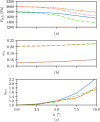
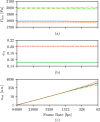

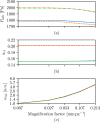
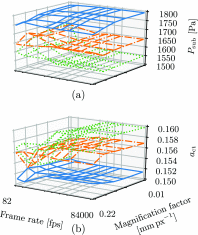

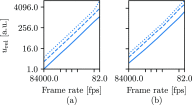
Similar articles
-
Bayesian estimation of vocal function measures using laryngeal high-speed videoendoscopy and glottal airflow estimates: An in vivo case study.J Acoust Soc Am. 2020 May;147(5):EL434. doi: 10.1121/10.0001276. J Acoust Soc Am. 2020. PMID: 32486812 Free PMC article.
-
Influence of spatial camera resolution in high-speed videoendoscopy on laryngeal parameters.PLoS One. 2019 Apr 22;14(4):e0215168. doi: 10.1371/journal.pone.0215168. eCollection 2019. PLoS One. 2019. PMID: 31009488 Free PMC article.
-
Adductory Vocal Fold Kinematic Trajectories During Conventional Versus High-Speed Videoendoscopy.J Speech Lang Hear Res. 2019 Jun 19;62(6):1685-1706. doi: 10.1044/2019_JSLHR-S-18-0405. Epub 2019 Jun 10. J Speech Lang Hear Res. 2019. PMID: 31181175 Free PMC article.
-
Glottal Adduction and Subglottal Pressure in Singing.J Voice. 2015 Jul;29(4):391-402. doi: 10.1016/j.jvoice.2014.08.009. Epub 2015 May 2. J Voice. 2015. PMID: 25944295
-
What have we learned about laryngeal physiology from high-speed digital videoendoscopy?Curr Opin Otolaryngol Head Neck Surg. 2005 Jun;13(3):152-6. doi: 10.1097/01.moo.0000163451.98079.ba. Curr Opin Otolaryngol Head Neck Surg. 2005. PMID: 15908812 Review.
Cited by
-
Exploring the mechanics of fundamental frequency variation during phonation onset.Biomech Model Mechanobiol. 2023 Feb;22(1):339-356. doi: 10.1007/s10237-022-01652-8. Epub 2022 Nov 12. Biomech Model Mechanobiol. 2023. PMID: 36370231 Free PMC article.
-
The influence of flow model selection on finite element model parameter estimation using Bayesian inference.JASA Express Lett. 2021 Apr;1(4):045204. doi: 10.1121/10.0004260. Epub 2021 Apr 15. JASA Express Lett. 2021. PMID: 34136884 Free PMC article.
-
Non-Linear Image Distortions in Flexible Fiberoptic Endoscopes and their Effects on Calibrated Horizontal Measurements Using High-Speed Videoendoscopy.J Voice. 2022 Nov;36(6):755-769. doi: 10.1016/j.jvoice.2020.08.029. Epub 2020 Sep 18. J Voice. 2022. PMID: 32958427 Free PMC article.
-
Voice Feature Selection to Improve Performance of Machine Learning Models for Voice Production Inversion.J Voice. 2023 Jul;37(4):479-485. doi: 10.1016/j.jvoice.2021.03.004. Epub 2021 Apr 11. J Voice. 2023. PMID: 33849760 Free PMC article.
-
Estimation of Subglottal Pressure, Vocal Fold Collision Pressure, and Intrinsic Laryngeal Muscle Activation From Neck-Surface Vibration Using a Neural Network Framework and a Voice Production Model.Front Physiol. 2021 Sep 1;12:732244. doi: 10.3389/fphys.2021.732244. eCollection 2021. Front Physiol. 2021. PMID: 34539451 Free PMC article.
References
Publication types
MeSH terms
Grants and funding
LinkOut - more resources
Full Text Sources
Medical

